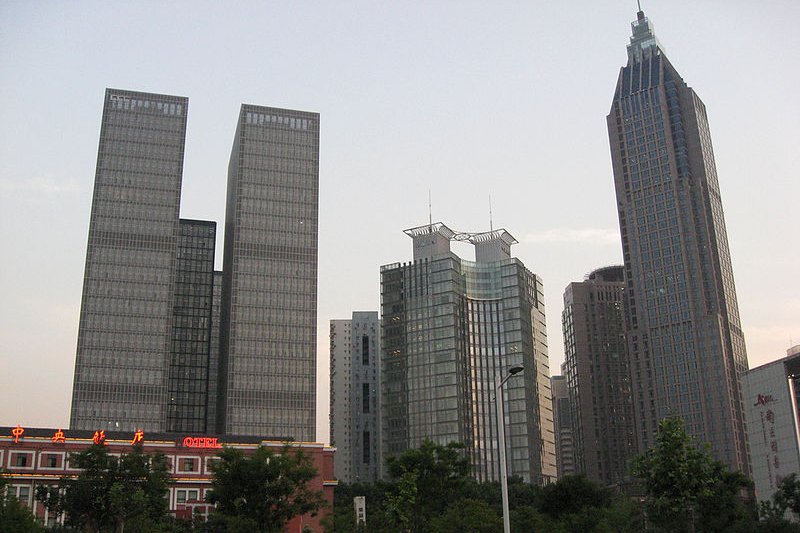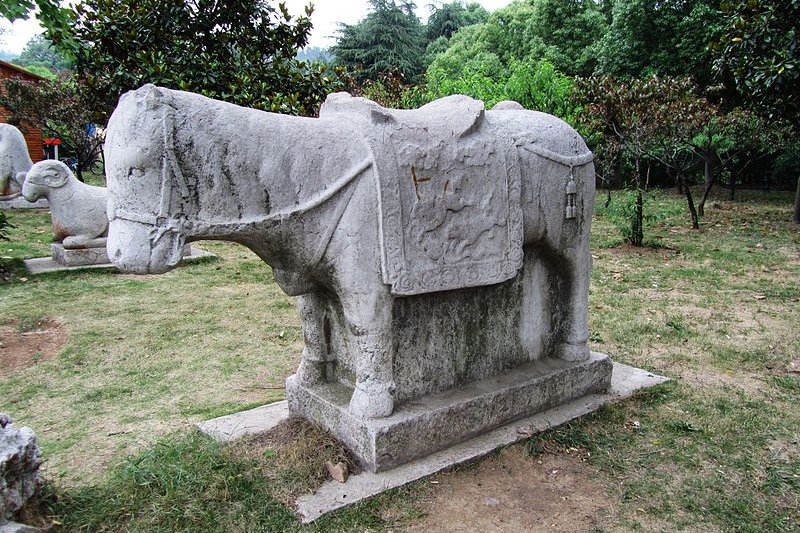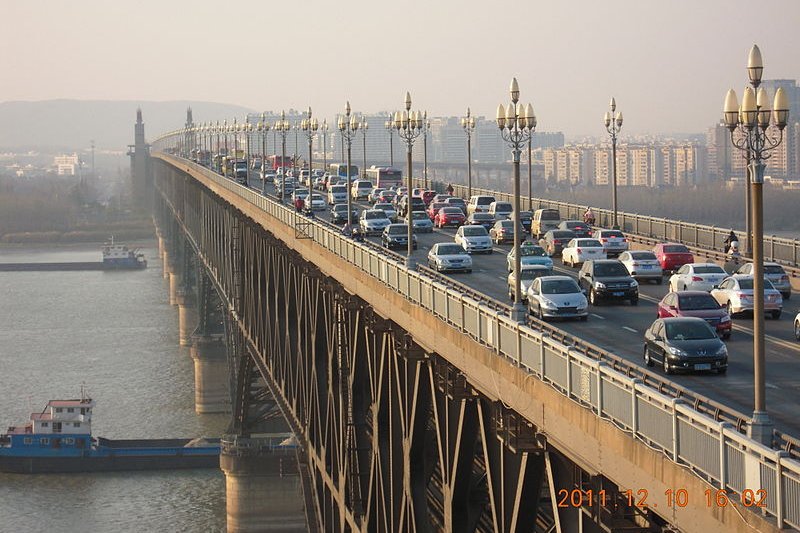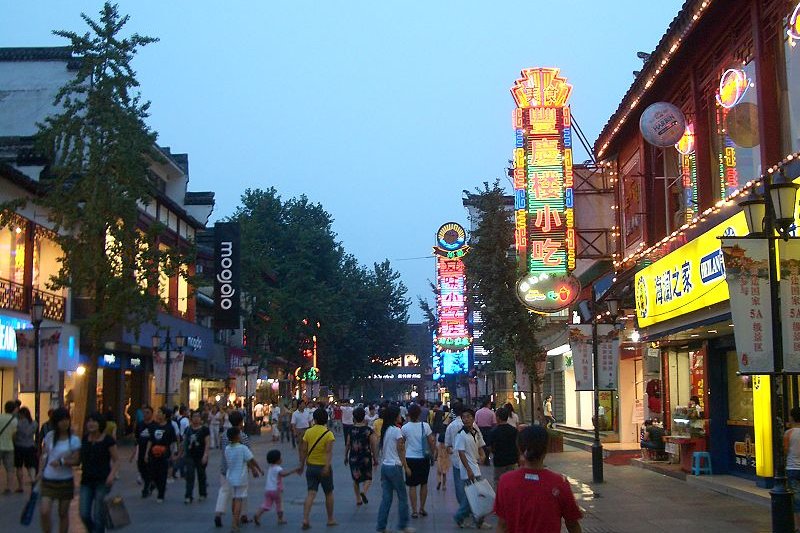 Downtown Nanjing
Downtown NanjingSource: https://commons.wikimedia.org/wiki/File:Nanjing_downtown_view.jpg
Author: taylorandayumi

Nanjing (南京) is the capital of Jiangsu Province, China. It is located in the lower Yangtze River basin. Nanjing is one of the Four Great Ancient Capitals of China, together with Beijing, Luoyang and Xi'an. It served as capital for six dynasties, and also served as the capital of the Republic of China
Today Nanjing is a modern city with a population of over five million people. It is the second largest commercial center in East China after Shanghai, and will play host to the 2014 Summer Youth Olympics.
The area of Nanjing was the site of an ancient city called Yecheng, founded in 495 BC during the State of Wu. In 333 BC, the State of Chu vanquished the State of Wu to establish Jinling Yi, to the northwest of present-day Nanjing.
 Stone carvings at the Tomb of Kang Maocai
Stone carvings at the Tomb of Kang Maocai
Author: taylorandayumi

Nanjing (南京) is the capital of Jiangsu Province, China. It is located in the lower Yangtze River basin. Nanjing is one of the Four Great Ancient Capitals of China, together with Beijing, Luoyang and Xi'an. It served as capital for six dynasties, and also served as the capital of the Republic of China
Today Nanjing is a modern city with a population of over five million people. It is the second largest commercial center in East China after Shanghai, and will play host to the 2014 Summer Youth Olympics.
The area of Nanjing was the site of an ancient city called Yecheng, founded in 495 BC during the State of Wu. In 333 BC, the State of Chu vanquished the State of Wu to establish Jinling Yi, to the northwest of present-day Nanjing.
 Stone carvings at the Tomb of Kang Maocai
Stone carvings at the Tomb of Kang MaocaiSource: https://commons.wikimedia.org/wiki/File:Stone_Carvings_of_the_Tomb_of_Kang_Maocai_01_2011-05.JPG
Author: 猫猫的日记本

Nanjing became a capital for the first time in AD 229, during the Three Kingdoms Period. The city was razed when the Sui Dynasty reunified China. It was reconstructed in the late Tang Dynasty and was named Jinling. Nanjing's medieval city walls, built during the reign of Hong Wu Emperor of the Ming Dynasty in around 1368 is today the longest surviving city wall in the world. Between 1358 and 1425, Nanjing is believed to be the biggest city in the world, with a population of 487,000.
Nanjing remained the capital until 1421, when the third emperor of the Ming Dynasty relocated the capital to Beijing. Two centuries later, Prince Zhu Yousong was enthroned in Nanjing in 1644. However the reign was shortlived.
Nanjing was selected as capital with the founding of the Republic of China in January 1912. However it only became capital in 1927 when the Kuomintang took over Beijing. The Japanese invasion of Nanjing led to be bloody Nanjing massacre. The Japanese established the capital in Nanjing while the Nationalist government moved its capital to Chongqing.
After the Japanese surrender, the Kuomintang reestablished the capital in Nanjing. In 1949 the People's Liberation Army ejected the Kuomintang from Nanjing. Since then, Nanjing has been the provincial capital of Jiangsu Province.
 Nanjing Yangtze River Bridge
Nanjing Yangtze River Bridge
Author: 猫猫的日记本

Nanjing became a capital for the first time in AD 229, during the Three Kingdoms Period. The city was razed when the Sui Dynasty reunified China. It was reconstructed in the late Tang Dynasty and was named Jinling. Nanjing's medieval city walls, built during the reign of Hong Wu Emperor of the Ming Dynasty in around 1368 is today the longest surviving city wall in the world. Between 1358 and 1425, Nanjing is believed to be the biggest city in the world, with a population of 487,000.
Nanjing remained the capital until 1421, when the third emperor of the Ming Dynasty relocated the capital to Beijing. Two centuries later, Prince Zhu Yousong was enthroned in Nanjing in 1644. However the reign was shortlived.
Nanjing was selected as capital with the founding of the Republic of China in January 1912. However it only became capital in 1927 when the Kuomintang took over Beijing. The Japanese invasion of Nanjing led to be bloody Nanjing massacre. The Japanese established the capital in Nanjing while the Nationalist government moved its capital to Chongqing.
After the Japanese surrender, the Kuomintang reestablished the capital in Nanjing. In 1949 the People's Liberation Army ejected the Kuomintang from Nanjing. Since then, Nanjing has been the provincial capital of Jiangsu Province.
 Nanjing Yangtze River Bridge
Nanjing Yangtze River BridgeSource: https://commons.wikimedia.org/wiki/File:Nanjing_Yangtze_River_Bridge.jpg
Author: Jack No 1

Nanjing's Lukou International Airport is located 35 kilometers from downtown Nanjing. The cheapest way to leave the airport is by bus. There are two express bus routes from the airport to Nanjing, both terminating at the Nanjing Railway Station. The fare is ¥20 and the ticket can be purchased at the kiosk outside the Arrival Hall.
By Train
The fast train takes just over two hours to go from Shanghai to Nanjing, and is a good option if you are visiting both cities. The Nanjing Railway Station is located near to the Zhongyangmen long-distance bus station.
The Subway Line 1 goes north-south through the city, with stops at the main shopping areas around Zhujiang Road and the Nanjing Railway Station.
Taxis are relatively inexpensive and is another option to consider. Always insist on using the meter. The meter starts at ¥9 and you can travel anywhere within Nanjing for less than ¥15.
 The entertainment precinct in Nanjing, China
The entertainment precinct in Nanjing, China
Author: Jack No 1

Planning your trip to Nanjing
By PlaneNanjing's Lukou International Airport is located 35 kilometers from downtown Nanjing. The cheapest way to leave the airport is by bus. There are two express bus routes from the airport to Nanjing, both terminating at the Nanjing Railway Station. The fare is ¥20 and the ticket can be purchased at the kiosk outside the Arrival Hall.
By Train
The fast train takes just over two hours to go from Shanghai to Nanjing, and is a good option if you are visiting both cities. The Nanjing Railway Station is located near to the Zhongyangmen long-distance bus station.
Exploring Nanjing
The most practical way to get around in Nanjing is to take the subway. Buy the stored-value card, Jinlingtong (also called IC-tong), which you can use to ride the subway and bus, and can also be used to purchases at the Suguo convenience stores. The cards can be bought at any subway station, bus station and Huaxia Bank branches.The Subway Line 1 goes north-south through the city, with stops at the main shopping areas around Zhujiang Road and the Nanjing Railway Station.
Taxis are relatively inexpensive and is another option to consider. Always insist on using the meter. The meter starts at ¥9 and you can travel anywhere within Nanjing for less than ¥15.
 The entertainment precinct in Nanjing, China
The entertainment precinct in Nanjing, ChinaSource: https://commons.wikimedia.org/wiki/File:Nanjing-Fuzimiao-area-shopping-street-3149.jpg
Author: Vmenkov

Looking for information on Penang? Use this Map of Roads in Penang to zoom in on information about Penang, brought to you road by road.

Author: Vmenkov

Places of Interest in Nanjing
- Zhonghuamen (Gate of China)
This is the southern gate of Nanjing's city wall. It is the best preserved example of early Ming fortification in Nanjing. - Taiping Heavenly Kingdom History Museum
This museum commemorates the anti-dynastic rebellion of 1851-64. - Bailuzhou Park (White Egret Park)
This park was originally the property of the Ming General Xu Da. It was restored in 1951. - Fuzi Miao (Temple of Confucius)
Seat of Confucian study for over 1,500 years. - Chaotian Gong (Heavenly Palace)
Once a place of ancestral worship, this complex of buildings is today the Municipal Museum. - Nanjing Massacre Memorial Hall
Memorial to those who perished under Japanese atrocities during World War II. - Tianchao Gong & Xu Yuan (Heavenly Kingdom Palace & Balmy Garden)
Originally built by a Ming prince, this building used to house the Republican Government under Sun Yat-sen and Chiang Kai-shek. - Meiyuan Xincun
Former Chinese Communist Party office in Nanjing. - Ming Palace Ruins
Remains of the old palace of the first Ming emperor Hongwu. - Provincial Museum
One of China's better museum showcasing artifacts from several dynasties. - Zijin Shan (Purple Mountain)
Site of the tomb of the first Ming Dynasty emperor, the mausoleum of Sun Yat-sen and tomb of Sun Quan from the Three Kingdoms period. - Xuanwu Lake
A huge lake, a popular imperial resort and today a recreational area. - Drum and Bell Towers
Restored medieval towers to house the city drum and bell. - Nanjing Yangtze River Bridge
Famous bridge across the Yangtze River built in the Socialist architectural style. - Mochou Lake
Lake named after a legendary heroine. - Tomb of the King of Borneo
Tomb to the king of Borneo who died while in Nanjing in the mid-14th century. - Qixia Si & Thousand Buddha Cliffs
This is one of the biggest Buddhist seminaries in China. Next to it is a cliff face with hundreds of Buddha statues carved into it.
 Latest updates on Penang Travel Tips
Latest updates on Penang Travel Tips
 Map of Roads in Penang
Map of Roads in Penang
Looking for information on Penang? Use this Map of Roads in Penang to zoom in on information about Penang, brought to you road by road.
Copyright © 2003-2025 Timothy Tye. All Rights Reserved.

 Go Back
Go Back